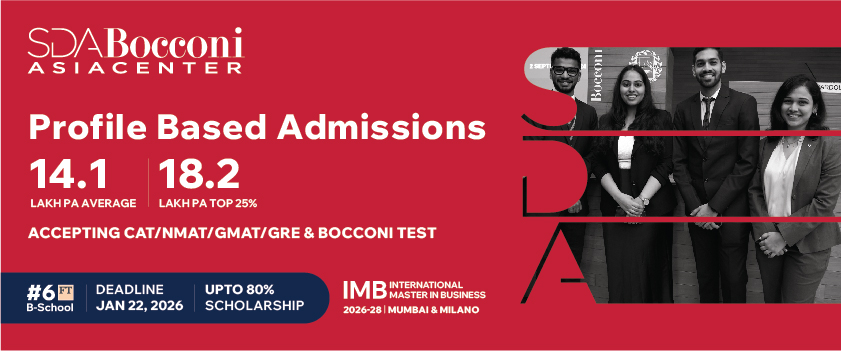The Great Indian BSchool Debate – Battle 4
JBIMS and MDI Gurgaon face off in the fourth battle of The Great Indian B School Debate. Comments will be enabled at 13:00:00 IST after the CounterPunch is uploaded
(Read here for Battle 1: IIM Lucknow vs FMS Delhi)
(Read here for Battle 2: IIM Ahmedabad vs IIM Bangalore)
(Read here for Battle 3: IIM Indore vs IIM Kozhikode)
Please note that the arguments put forward below cannot be ascribed as the participants’ individual opinions. All arguments put forward are only for the purpose of this debate competition.
There is little value add from classroom learning at Bschools in India
FOR the motion: JBIMS (Read MDI Gurgaon's argument AGAINST the motion)
Why does one do an MBA? The answer is simple and yet profound- it teaches you to think like a business person. Business people tend to think in terms of strategies and value, and human (customers and investors) relations. Management education is supposed to provide you with acumen that business persons would traditionally develop only after years of experience along with the analytical frameworks- risk assessments, cost-benefit analyses and strategic plans- that you can apply to any problem or opportunity you encounter. Until a few years ago management education revolved around classroom theory with very little focus on practice. But the business world is looking for something different. To keep up with this demand, business schools are focussing more on experiential learning to prepare their students for the real world.
We do not deny that classroom education is a necessary part of an MBA; with people of various backgrounds interested in management some theoretical study is a must. But management education is more than classroom teaching- lectures, case studies, discussions, tutorials and projects. It is an attempt to be in the shoes of a business person and experience the risk he/she takes for the returns he/she desires. Universities world across have recognized that such an experience cannot be provided in a classroom and initiatives have been taken to educate in a manner which prepares the students to survive in the business world.
Classroom teaching has come a long way from the chalk and board era; we now have presentations, slide shows and videos to serve as teaching aids. Despite such advancements, the disadvantages of classroom teaching being the focus of management education are many:
1. Although isolation is a classroom’s biggest strength in that students can learn theoretical concepts, it is also its greatest weakness- with MBA students spending most of their time in the classroom their exposure to the world is limited. How can a class on consumer behaviour ever replace the experience of seeing consumers interacting with the environment of a mall or a supermarket?
2. It is true that subjects like statistics and accounting require some theoretical groundwork which a classroom provides, but the student finds value in these subjects only when he is exposed to real world applications like financial reports, marketing research data etc. Classroom training in such cases is inadequate.
3. The Case Study approach may have given classroom teaching a new direction, but it has its disadvantages. With several case studies being obsolete and many irrelevant in the current business scenario, this approach only makes the classroom more inept in preparing its students.
4. Classrooms attempt to teach soft skills like communication, negotiation and leadership. While the classroom could give insights into the human psyche and frameworks to communicate well, such skills are best learnt with real-world practice, the classroom making a poor simulation environment. As the Latin saying goes- usus magister est optimus (Experience is the Best Teacher).
We believe that managers and business persons study the world. From their understanding, they attempt to make profitable business decisions. It sounds easy, but let’s not forget the risk, the stress and the rush involved in the decision making. Classroom training is grossly incapable of providing such an experience to management students. Hence look beyond the classroom as have many business schools across the world:
1. Summer Internships- Every management student is a different person when he/she returns from the summer internship. The hands-on experience helps students understand the business environment and even their own strengths and weaknesses. Is it any wonder that most B-schools across the world have made summer internships an important part of their curriculums?
2. Live Projects- Students have opportunities to work in teams with the industry on real-world business issues, thus applying the classroom lessons to gain new business perspectives and better understanding of major global issues. Students can thus integrate their theoretical concepts with business practices. Such projects help students understand marketing and growth strategies, new product development, financial analysis of companies to develop portfolios etc.
3. Research Papers- Students with interests in specific sectors or areas of management should conduct research alongside faculty members thus studying the business world in a structured manner and adding to his knowledge. Research can also help understand environments and situations not generally dealt by classroom training- sports, public systems, alternative investment avenues, hospitals etc.
4. Simulation Labs- Such innovations provide a variety of experiential learning opportunities to take what a student learns in the classroom and apply it into practice. In simulations, the player has to make all the applicable decisions to win the market—everything from setting the price of the “product” to determining the distribution network and the advertising campaign budget. For finance students, the simulations are an introduction to the world of capital markets, investments, securities and derivatives. It is next to impossible to create such a learning environment in a classroom.
5. Field Visits and Guest Lectures- Which is better? A professor explaining world-class manufacturing practices in the classroom or seeing the relevant technology being in a factory as a supervisor tells you about the issues he faces daily. How about choosing between a case study on Indiabulls or listening to Mr Gagan Banga as he stands before you and says "Our aim is simple: we have to be amongst the top two or three players in whatever business we are in.”[1]
Several business schools have thus revised their curriculums to less coursework and more practice:
Table 1 [2][3][4][5][6][7][8][9][10]
| Name Of B-school | Experiential Learning Initiatives |
| MIT Sloan | Action learning labs like India Lab, China Lab, Global entrepreneurship lab |
| Harvard | Field Immersion Experiences for Leadership Development (FIELD) |
| LBS | Simulation and computerized methods, field visits |
| Chicago Booth School | Experiential learning through live cases |
| Dartmouth Tuck College | Classroom learning is only 10% other being case studies and team projects |
| Kellogg | lab-based courses as GIM, KWEST and Global lab |
| Wharton | Simulation games like Future view |
| Duke Fuqua | Simulations |
| INSEAD | Role plays and simulations |
| ISB | Centres of excellence working on research related to aspects of management |
Our point is simple. Classroom training is relevant even today in management education. But it isn’t the centre. The centre is experiential learning. Classroom training is a support module, albeit an important one. Management education should be a process of constant refinement of learning through an iterative sequence of theory, practice, and reflection. We believe an MBA is a gateway to concept of “Learning by doing” and hence there is a need to integrate classroom theory and real-world practice.
- Gaurav Mashalkar and Karan B Mehta (JBIMS)

Counterpunch
The overall sentiment, as reflected, in the argument of our esteemed opponents seems to be that classroom learning is not the centre, but it is experiential learning instead. We do not deny the importance or the value added by other aspects of management education. Our argument is that classroom learning adds value and not that it is the only source of value addition – in line with the topic of the debate.
Team JBIMS in their opening paragraph, have stated that “Management education is supposed to provide you with acumen that business persons would traditionally develop only after years of experience”. But management education aims only to equip one with the tools to enable sound decision making and not to develop acumen in students.
“We do not deny that classroom education is a necessary part of an MBA” as stated by our opponent is the very crux of our argument that there is value addition to be had from classroom education.
In reference to Team JBIMS’ point that classroom education cannot substitute on-field observations or experiences, we can only add that classroom learning is not supposed to do that in the first place. Its importance lies in imparting the concepts and skills needed to make sense of the world of business.
The value of case studies lies in the lessons learnt and not the period to which it belongs. Obsolescence of cases, if at all a flaw, cannot to be attributed to the classroom learning model itself.
While classrooms emphasize the importance of soft skills such as communication and negotiation, they do not attempt to teach them. Acquiring these soft skills is a prerogative of the students.
The reason that Summer internships are scheduled after a year into management education is that the concepts and skills acquired through classroom learning may find application in business. Live projects require application of theoretical concepts taught in classrooms. The basis for any research is classroom fundamentals. Simulation games, field visits and guest lectures have their roots in the classroom and cannot be considered as falling outside its ambit.
While we agree that the aforementioned methods of learning are essential in providing experiential learning, the basis for each of them without exception is the classroom.
Our opponents have made an attempt at a cogent argument by citing methods adopted by international B-Schools, but we would like to point that this is outside the scope of the topic which by definition limits the debate to the Indian context. Besides, while the table seems to suggest the adoption of new methods, it in no way undermines the importance of the value addition that can be had from a classroom. Neither does it imply that the adoption of these methods effectively acts as a replacement to the classroom.
We would like to conclude by saying that ‘Classroom learning is the compass and not the map.’
Bibliography (Opening argument)
1. http://www.business-standard.com/india/news/lunchbs-gagan-banga/320748/
2. http://mba.insead.edu/academics/learning_methodology.cfm
3. http://faculty.fuqua.duke.edu/~pecklund/FacultyWeb/Teaching.htm
4. http://poetsandquants.com/2010/06/28/dartmouths-tuck-vs-stanford-graduate-school-of-business/
5. http://www.topmba.com/institution/the-university-of-chicago-booth-school-of-business
6. http://www.london.edu/programmes/mba/programmedetails/learningmethods.html
7. www.hbs.edu/mba/academics/FIELD/globalpartner.html
8. http://mitsloan.mit.edu/globalmitsloan/initiatives.php
9. http://www.isb.edu/intermediatepages/Centres_of_Excellence.shtml
10. http://www.wharton.upenn.edu/mba/academics/faculty-profile-peter-fader.cfm
